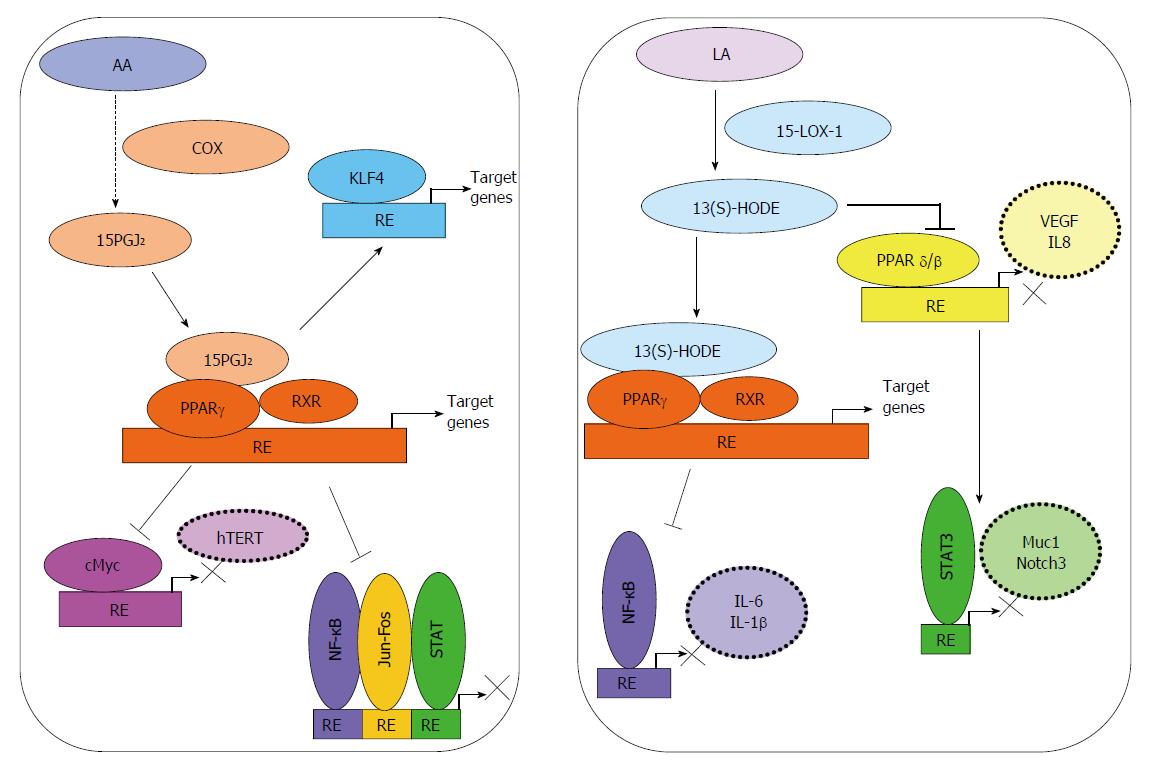Copyright
©The Author(s) 2015.
World J Gastroenterol. Nov 7, 2015; 21(41): 11748-11766
Published online Nov 7, 2015. doi: 10.3748/wjg.v21.i41.11748
Published online Nov 7, 2015. doi: 10.3748/wjg.v21.i41.11748
Figure 1 Enzymatic metabolism of polyunsaturated fatty acid can generate bioactive lipids that induce inflammation, tumorigenesis, and thrombosis, while also generating mediators with anti-tumorigenic, pro-resolution properties.
In the pro-tumorigenic arm, arachidonic acid (AA) is metabolized via the cyclooxygenase (COX) pathway to generate prostaglandins (PGE2, PGI2) and thromboxanes (TxA2). Lipoxygenase (LOX) enzymes convert AA to hydroxyeicosatetraenoic acids (HETEs), which are active on their own, or can be further converted to leukotrienes (LTs). In the anti-tumorigenic, pro-resolution arm, metabolism of AA through 15-LOX1/2 or acetyl salicylic acid (ASA) acetylated COX-2 generates intermediates that can be converted to lipoxins (Lxs) through the transcellular activity of other LOXs (5- or 12-LOX). Conversion of linoleic acid (LA) to 13(S)-HODE may produce anti-inflammatory effects mediated through activation of PPARγ. The fish oils eicosapentaenoic acid (EPA) and docosahexaenoic acid (DHA) may be converted by acetylated COX-2 to pro-resolution mediators E- and D- series resolvins (Rvs), respectively. PUFA: Polyunsaturated fatty acid.
Figure 2 Activation of PPARγ by bioactive lipids can modulate signaling in progressive colorectal cancer.
15-deoxy-delta(12,14)-prostaglandin J2 (15-PGJ2), generated from arachidonic acid (AA) by the enzymatic action of COX-2, acts as a ligand for PPARγ. Co-activators such as RXR activation of tumor suppressive signaling through Kruppel-like factor 4 (KLF4) in colorectal cancer (CRC) have also been reported. Binding to co-repressors may lead to repression of various transcription factors such as nuclear factor kappa B (NF-κB), AP1 (Activator Protein-1, c-Jun and c-Fos), c-Myc or STAT. 13(S)-hydroxyoctadecadienoic acid [13(S)-HODE], generated by oxygenation of linoleic acid (LA) by 15-LOX-1, can act as a ligand for PPARγ and lead to inhibition of NF-κB activity. 13(S)-HODE may also inhibit the transcriptional activities of PPARβ/δ and STAT3, and thereby reduce inflammation and angiogenesis in CRC.
- Citation: Tuncer S, Banerjee S. Eicosanoid pathway in colorectal cancer: Recent updates. World J Gastroenterol 2015; 21(41): 11748-11766
- URL: https://www.wjgnet.com/1007-9327/full/v21/i41/11748.htm
- DOI: https://dx.doi.org/10.3748/wjg.v21.i41.11748










